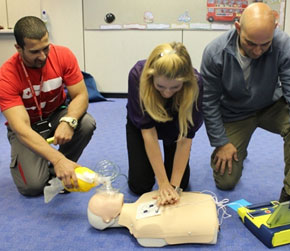Training Defibrillator
For those that wish to learn how to use a defibrillator, a training defibrillator is a great choice. It is a defibrillator that is not going to send the electrical impulse when it is used. This is great for medical students and other healthcare students. The training defibrillator should be functional in that it will turn on and mimic the actions of normal defibrillators. Of course, using a real defibrillator on other students or any healthy person is not an option. Before using a training defibrillator, you should first understand what defibrillators are and how they work with the heart.
How Training Defibrillators Work Alongside a Failing Heart
A defibrillator is a piece of equipment that can be used on a failing heart. The heart works by supplying all the cells in our body with nutrient-rich blood. This is a vital physiological function of our heart, so vital in fact, that without it, we would die. This is why the defibrillator is so important. The heart receives its signal from cells within the heart that make up the pacemaker, known as the SA node. The SA node sends a signal to the atria and then, via the AV node, sends a signal to the ventricles. This happens over and over again; in fact, this happens about 2.5 billion times in the average person’s life.
For the heart to function properly, all of the pacemaker cells must also function properly. When a heart is in danger of failing for a number of reasons (the biggest of which is aging), it can go into cardiac arrest. This is when a defibrillator is used. The defibrillator works to de-fibrillate (fibrillation is a common occurrence in heart failure) the heart by sending an electrical impulse to the heart’s SA node to hopefully reset it to send the signal to the muscle cells properly. For those that have a sluggish SA node, sometimes a pacemaker is inserted. But inserting a pacemaker is only possible when the heart is still beating.
Buying a Training Defibrillator
A training defibrillator can be purchased from some medical training supply companies. Another option is to practice with a real defibrillator, but make sure it is not set to do any “shocking.” Practicing on a dummy is also great when using an actual defibrillator, as it will not matter if the electrical impulse is sent, in that no one will be injured. This is another option to work with a training defibrillator.
Working with a defibrillator is very serious, so care should be taken to ensure any users have proper training. This is especially true when the defibrillator is a manual one, as opposed to AEDs (automated external defibrillators), which work out all the complicated details automatically. These are the types of defibrillators one would find in schools and other public places. A training defibrillator can be a very valuable tool for those that are learning how to use a defibrillator effectively. Whether you are the student or you are training the class, it is very important to work with a training defibrillator.

